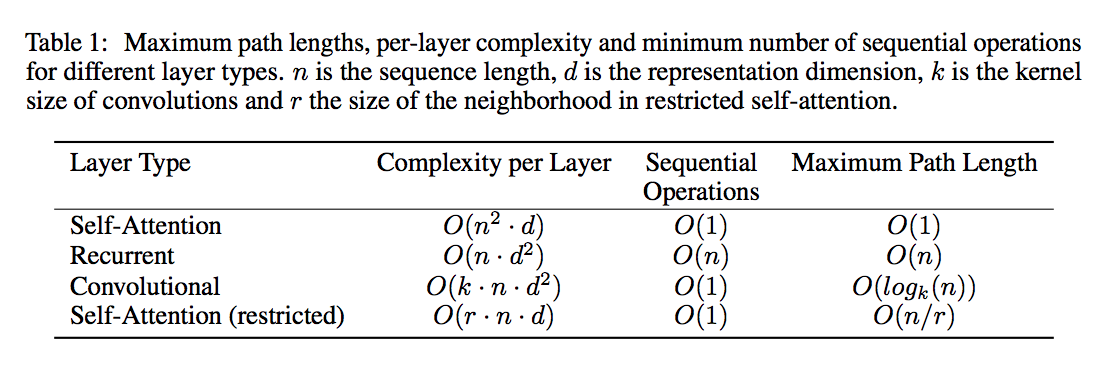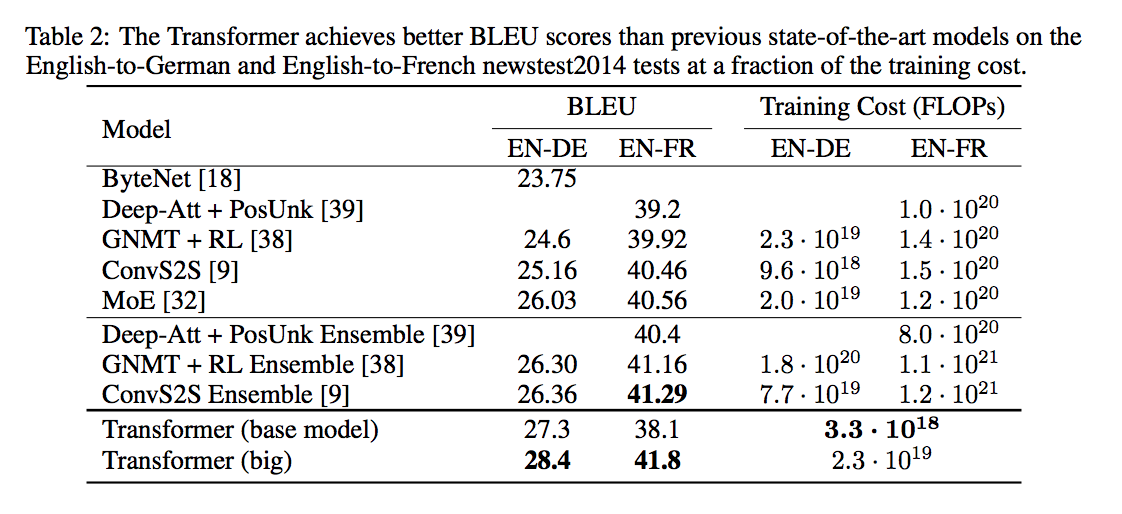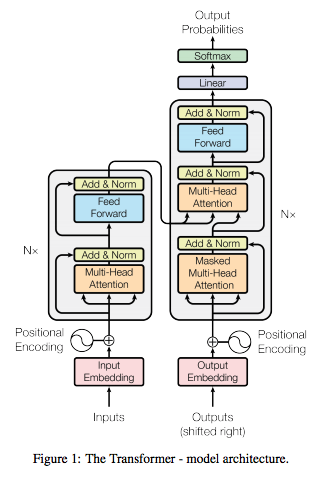概要
- 今回紹介する論文
- Attention Is All You Need
- Google BrainやGoogle Researchの人たちが2017年6月に発表した。
- (この記事で使用している図表は論文からの転載です。)
- 内容:
- 新しい翻訳モデル(Transformer)の提案。既存のモデルよりも並列化に対応しており、短時間の訓練で高いBLEUスコアを達成した。
- TransformerはRNNやCNNを使わず、attentionメカニズムに基づいている。
- 実装例:
- その他:
Introduction
- 今までのNeural machine translation(NMT)はRNNやCNNを使っているものが多い。
- RNN(LSTM、GRU等)は文章(単語列)を前から順に入力とし、前の単語に依存する。
- t番目の状態 $h_t$ を計算するために、t番目の単語とt-1番目の状態 $h_{t-1}$ を使用する。
- しかし、RNNだと並列化が難しく、特に文章が長いと計算時間が長くなる/メモリ使用量が多くなる。
- メモリ使用量に関しては、"factorization tricks"や"conditional computation"といった研究がある。
- ほとんどすべての翻訳モデル等では、attention構造を入れることで精度の改善がされている。
- この論文で提案するTransformerはRNNやCNNを使わない。
- 論文のタイトルの通り、attention構造を使う。
モデルの全体像
- エンコーダー・デコーダー構造を持つ。
エンコーダー
- 上図の左側。
- N個(=6)のlayerからなる。
- 各layerの下記の2個のsub-layerを持つ。(※詳細は後述)
- multi-head self-attention mechanism
- position-wise fully connected feed-forward network
- 各sub-layerのアウトプットは下記のようにresidual connectionとlayer normalizatonを行う。
- $\text{LayerNorm}(x + \text{Sublayer}(x))$
- 各layerとembeddingアウトプットは $d_{\text{model}}$ 次元(=512)になる
デコーダー
- 上図の右側
- デコーダーもN個(=6)のlayerからなる。
- 各layerの下記の3個のsub-layerを持つ。(※詳細は後述)
- masked multi-head self-attention mechanism
- $i$ 番目の文字を予測するために、$i-1$ 番目までの文字のみを利用するようにマスクを行う。
- multi-head attention mechanism
- エンコーダーのアウトプットへのattentionを行う。
- position-wise fully connected feed-forward network
- masked multi-head self-attention mechanism
データの流れ
エンコーダー
- Input
- 文字列 $\bar{w} = (w_1, w_2, ..., w_{N})$
- ただし、$w_1=\text{bos}$ 、 $w_N=\text{eos}$
- Endedding
- $E = \text{Embed}(\bar{w}) \in R^{N \times d_{model}}$
- Positional Encoding
- $\bar{E} = \text{Positional}(E) \in R^{N \times d_{model}}$
- Multi-head self-attention
- $Q = f_Q(\bar{E}) \in R^{N \times d_k}$
- $K = f_K(\bar{E}) \in R^{N \times d_k}$
- $V = f_V(\bar{E}) \in R^{N \times d_k}$
- $M = \text{MultiHead}(Q, K, V) \in R^{N \times d_{model}}$
- Add & Norm
- $\bar{M} = \text{LayerNorm}(\bar{E} + M) \in R^{N \times d_{model}}$
- Position-wise fully connected feed-forward network
- $F = \text{LayerNorm}(\bar{M}) \in R^{N \times d_{model}}$
- Add & Norm
- $\bar{F} = \text{LayerNorm}(\bar{M} + F) \in R^{N \times d_{model}}$
デコーダー
- エンコーダーとほぼ同じ。違いは1番目のsub-layerでmaskを行うこと、2番目でエンコーダーの結果からKとVを計算すること。
- Mask
- Positional encodingの結果を $\bar{E} \in R^{N \times d_{model}}$ とする。
- i 番目の単語の予測を行うとき、$\bar{E}$ の $i$ 行 から $L$ 行の要素すべてを0にする。
モデルの構成要素
- Transformerを構成する要素の紹介
- N を文章の長さとする。
Embedding
- 単語を $d_{model}$ 次元のベクトルで表す
Positional encoding
- RNNのようにモデルの構造が単語の順序関係を持っていないので、位置情報を付与する。
- 文章における単語の位置とembeddingの位置に依存して決まる。
- 奇数/偶数で分ける
- $PE(pos, 2i) = \sin(pos/10000^{2i/d_{model}})$
- $PE(pos, 2i+1) = \cos(pos/10000^{2i/d_{model}})$
Scaled dot-product attention
- $\text{Attention}(Q, K, V) = \text{softmax}(\frac{QK^T}{\sqrt{d_k}})V$
- $Q \in R^{N \times d_k}$
- $K \in R^{N \times d_k}$
- $V \in R^{N \times d_v}$
- $\text{Attention}(Q, K, V) \in R^{N \times d_v}$
Multi head attention
- $\text{MultiHead}(Q, K, V) = \text{Concat}(\text{head}_1, ..., \text{head}_h) W^O$
- $\text{head}_i = \text{Attention}(QW^Q_i, KW^K_i, VW^V_i)$
- $W^Q_i \in R^{d_{model} \times d_k}$
- $W^K_i \in R^{d_{model} \times d_k}$
- $W^V_i \in R^{d_{model} \times d_v}$
- $W^O \in R^{h d_{k} \times d_{model}}$
- $\text{MultiHead}(Q, K, V) \in R^{N \times d_{model}}$
Multi head self attentionのQ, K, V
- Self-attention
- 文字列に対してEmbeddingとPositionalEncodingを対したものをXとする。
- $X \in R^{N \times d_{model}}$
- $Q=f_Q(X)$
- ${q_{ij}} = {a^Q_j x_{ij}}$
- $K=f_K(X)$、$V=f_V(X)$ も$f_Q$と同じ。
- 文字列に対してEmbeddingとPositionalEncodingを対したものをXとする。
- Attention
- $Q=f_Q(X)$
- $K=f_K(Z)$、$V=f_V(Z)$
- $Z$ はencoderの出力結果
Position-wise feed-forward network
- $\text{FFN}(x) = \text{ReLU}(x W_1 + b_1)W_2 + b_2$
Training方法
ハードウェア
- 8 NVIDIA P100 GPUs
- AWSでこれよりも高性能のGPUが使える。
- 新インスタンス- NVIDIA Tesla V100 GPUを最大8個搭載したAmazon EC2インスタンス P3
- V100のほうがP100よりも3倍程度速いらしい。
- 1ステップ約0.4秒。100,000ステップを12時間で学習
- big modelは1ステップ約1.0秒。300,000ステップを3.5日で学習
最適化手法
- Adam optimizerを仕様し、learning rateを下記のように調整
- $lrate = d_{model}^{-0.5} \min(step_num^{-0.5}, step_num \cdot warmup_steps^{-1.5})$
正則化
Residual dropout
- 各sub-layerに対してdropoutを行ってから、Add & Normを行う
- $\text{LayerNorm}(x + \text{DropOut}(\text{Sub}(x), P_{drop}))$
Label smoothing
- モデルが出力するのは各単語に対する確率なので、{0, 1}の正解ラベルをスムージングする。
- $q(k) = (1 - \epsilon) \delta_{k,y} + \frac{\epsilon}{K}$
- Transformerでは、$\epsilon=0.1$としている。
- これによりperplexityは悪化したが、accuracyとBLEUは改善した。
- Christian Szegedy, Vincent Vanhoucke, Sergey Ioffe, Jonathon Shlens, and Zbigniew Wojna.
Rethinking the inception architecture for computer vision. CoRR, abs/1512.00567, 2015.
パフォーマンスなど
各Layerの複雑さなど
- RNNやCNNによるattention構造との比較
- layerごとの計算の複雑さ
- 並列化できる計算の量
- 長期依存のパスの長さ

BLEUスコア
- English-to-Germanのケースデスはbase modelでも他の手法に比べ最高スコアを出している。big modelを使うことで更に精度が向上している。

実際に使ってみる
- 追記する。
